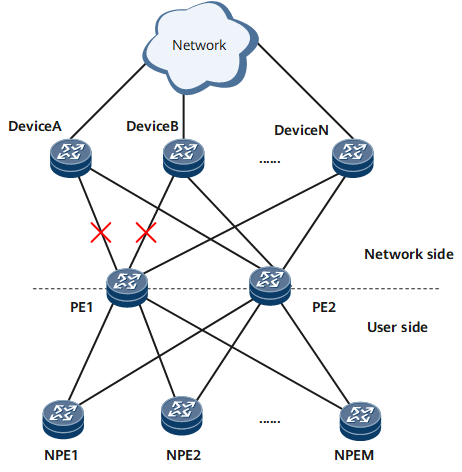Application of Interface Monitoring Group
Network-side interfaces can be added to an interface monitoring group. Each interface monitoring group is identified by a unique group name. The network-side interface to be monitored is a binding interface, and the user-side interface associated with the group is a track interface, whose status changes with the binding interface status. The interface monitoring group monitors the status of all binding interfaces. When a specific proportion of binding interfaces goes Down, the track interface associated with the interface monitoring group goes Down, which causes traffic to be switched from the master link to the backup link. When the number of Down binding interfaces falls below a specific threshold, the track interface goes Up, and traffic is switched back to the master link.
In the network shown in Figure 1, PE2 backs up PE1. NPE1 through NPEM on the user side are dual-homed to the two PEs to load-balance traffic, and the two PEs are connected to Router A through Router N on the network side. When only the link between PE1 and Router N is available and all the links between PE1 and all the other routers fail, the NPEs do not detect the failure and continue sending packets to Router N through PE1. As a result, the link between PE1 and Router N becomes overloaded.
To resolve this problem, you can configure an interface monitoring group and add multiple network-side interfaces on the PEs to the interface monitoring group. When a link failure occurs on the network side and the interface monitoring group detects that the status of a certain proportion of network-side interfaces changes, the system instructs the user-side interfaces associated with the interface monitoring group to change their status accordingly and allows traffic to be switched between the master and backup links. Therefore, the interface monitoring group can be used to prevent traffic overloads or interruptions.
